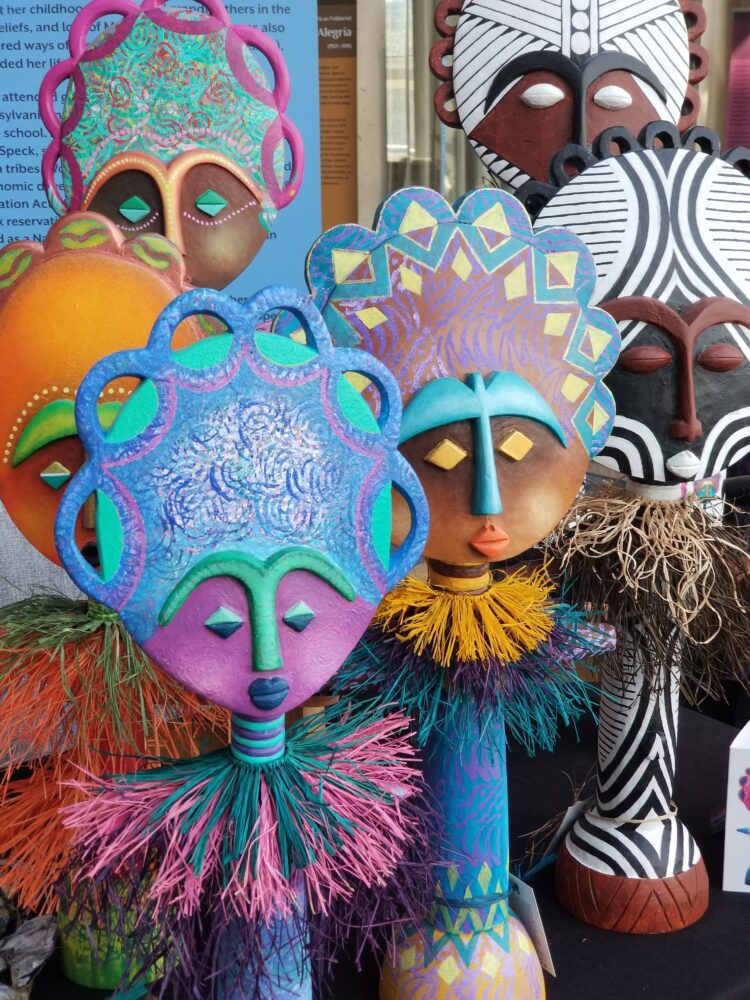
The Calling: The Transformative Power of African American Doll and Puppet Making
Celebrating senior visual storytellers who chronicle the history, identity and culture of their communities
October 6, 2023 – March 2, 2024
Curator Camila Bryce-Laporte & Consulting Scholar Phyllis May-Machunda
City Lore, an Affiliate of the Smithsonian Institution and a pioneer in Urban Folklore programming is pleased to announce the launch of a new exhibition entitled, The Calling: The Transformative Power of African American Doll and Puppet Making.
“The Calling: The Transformative Power of African American Doll and Puppet Making,” is conceived and curated by Camila Bryce-Laporte, (a noted doll maker herself) in partnership with scholar Phyllis M. Machunda. This exhibition includes dolls and puppets created by a group of 26 nationally acclaimed multi-media artists from the African Diaspora, who came of age in communities in the United States during the height of the Civil Rights and Black Arts Movements. Using mixed media, these visual storytellers chronicle the history, identity, and culture of their communities. Compelled or “called” to continue the special and enduring tradition of Black doll making, these artists recognize that their works are healing and transformative for themselves and for the communities they represent.
Organized into historic themes, the site-specific installation, also contextualizes the art as well as the art makers themselves, and includes videotaped conversations with the artists about their personal histories, the communities from which they emerged, their creative processes, and the transformative and spiritual power of their creations. The exhibition is appropriate for all ages and is supported by public programs, workshops, and a market day and is .
The exhibition is one of the inaugural projects of City Lore’s Cultural Ambassadors Residency Program, supported by the Institute for Library and Museum Services (ILMS).
“Rich with symbolism, all the artists have stories to tell, “ said Bryce-Laporte. “Each one of the 26 artists in the show was asked to create work that weaves a 400-year legacy into a multi-layered tapestry of expression.”Furthermore, as a group these artists defy the conventional
notion of dolls and puppets. We use our gifts and create as the spirit leads us.”
“City Lore,” says Founding Director Steve Zeitlin, shares curator Camila Bryce Laporte’s deep interest in African American history and culture. The Calling, an exhibit about Black dolls made by hand, with needle and thread, the softness of cloth, and the playfulness of puppetry, speaks to City Lore’s abiding passion for the art of everyday life.”
Participating Artists include: Kibibi Ajanku, Kay Williams Anderson, Judy Boldon Bain, Diana Baird N’Diaye, James Brown, Jr., Camila Bryce-Laporte, Karen Y. Buster, Kimberly Camp, Schroeder Cherry, Tracey Marlené Connor (photographer), IBé Crawley, Gloria Gammage Davis, Julee Dickerson-Thompson, Shimoda Donna Emanuel, Laura R. Gadson, Francine Haskins, Geraldine “Jeri” Hubbard, Ingrid Humphrey, Aundra McCoy, Sehar Peerzada, Paulette Richards, Elaine Robnett Moore, Imani W. Russell, Yolanda Sampson, Cynthia Sands, and Paula Whaley.

Parampara, the Sanskrit word for lineage, refers to the modes of learning a craft passed on through oral tradition. This exhibit presents ways of teaching and learning in a variety of cultures and art forms from ten artists who learned their art informally, in family and community settings, or in mentor and apprentice relationships.
This exhibit presents ways of teaching and learning in a variety of cultures and art forms from ten artists who learned their art informally, in family and community settings, or in mentor and apprentice relationships. This exhibit highlights seven modes of teaching and learning, drawing on the experiences of the ten featured artists: Amino Belyamani, Aurelia Fernández, Haifa Bint-Kadi, Hector Morales, Malini Srinivasan, N’Ketiah Brakohiapa, Potri Ranka Manis, Rokafella, Sidiki Conde, and Quraishi.
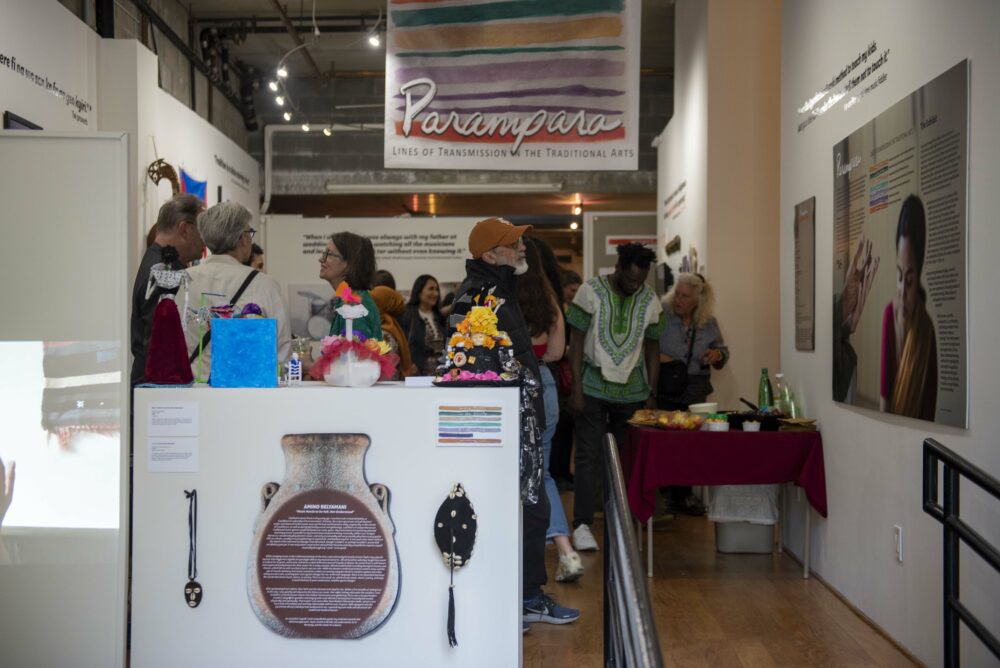
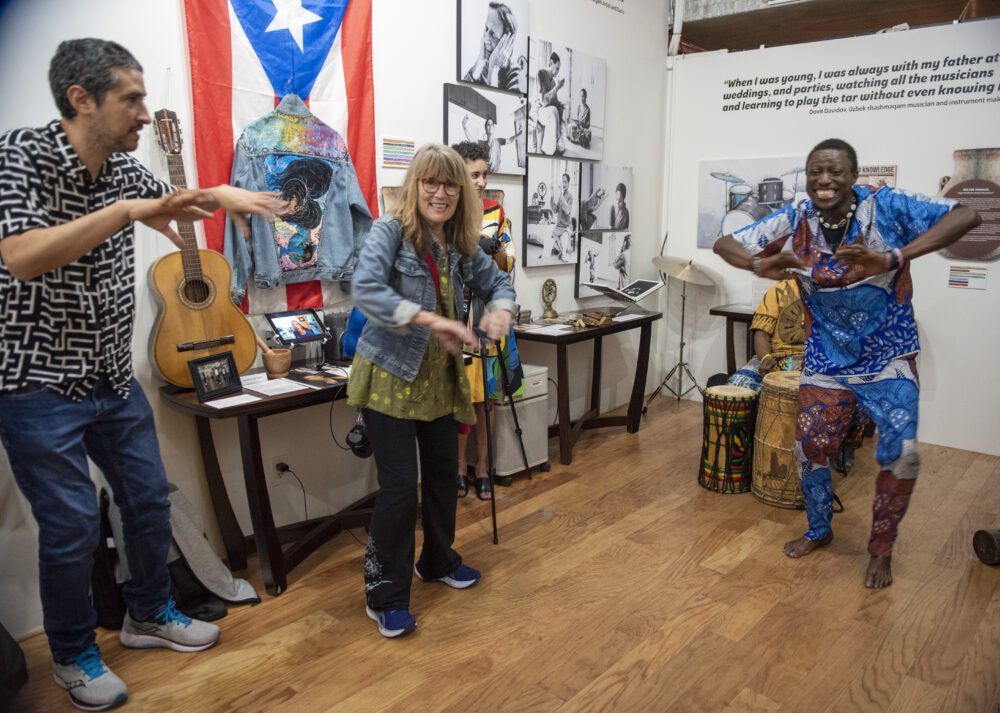
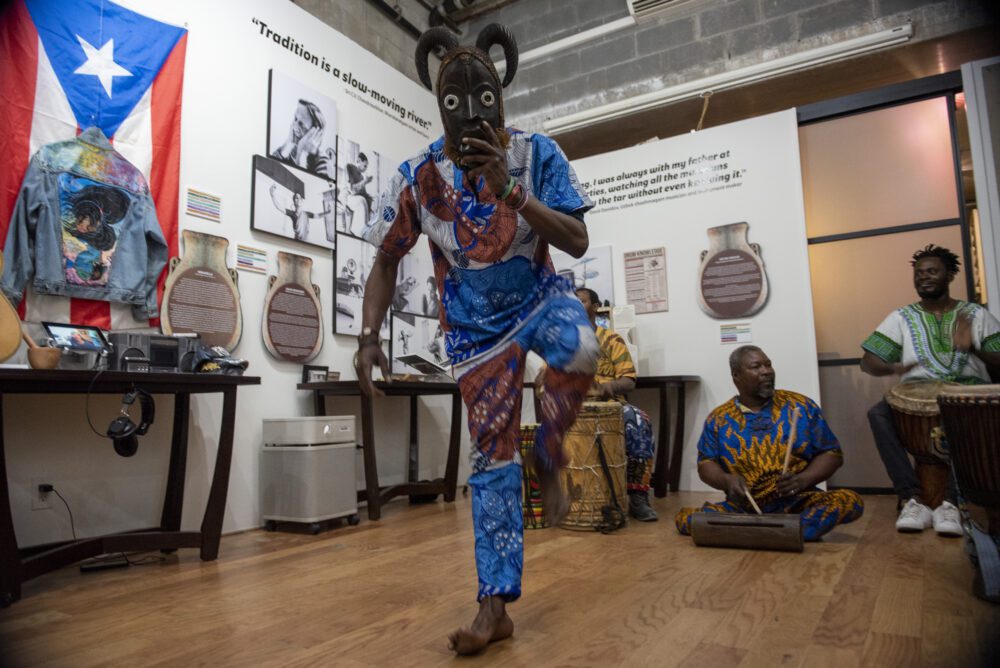


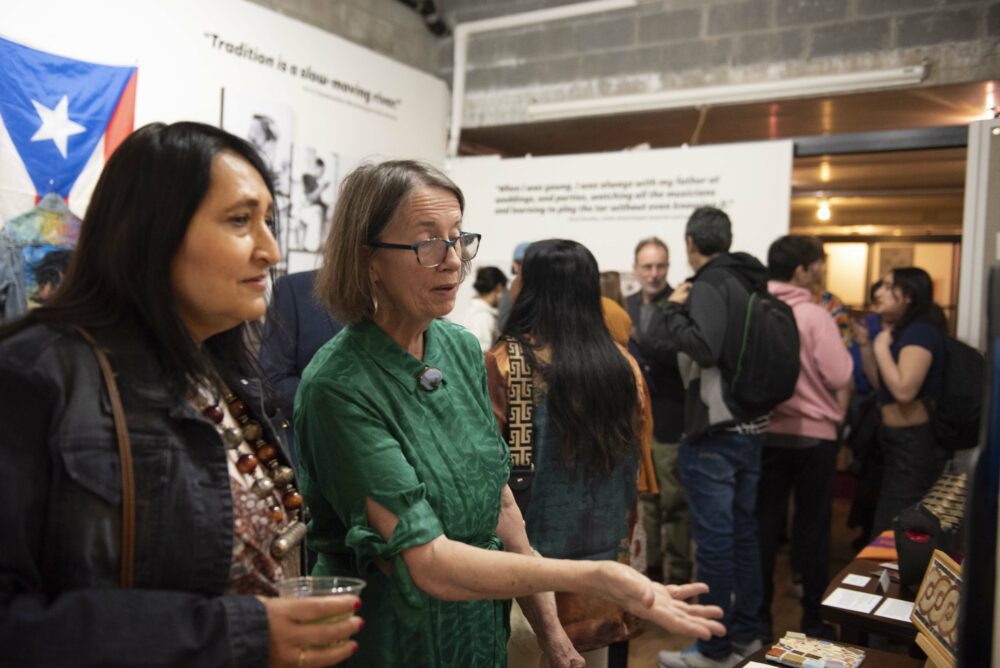
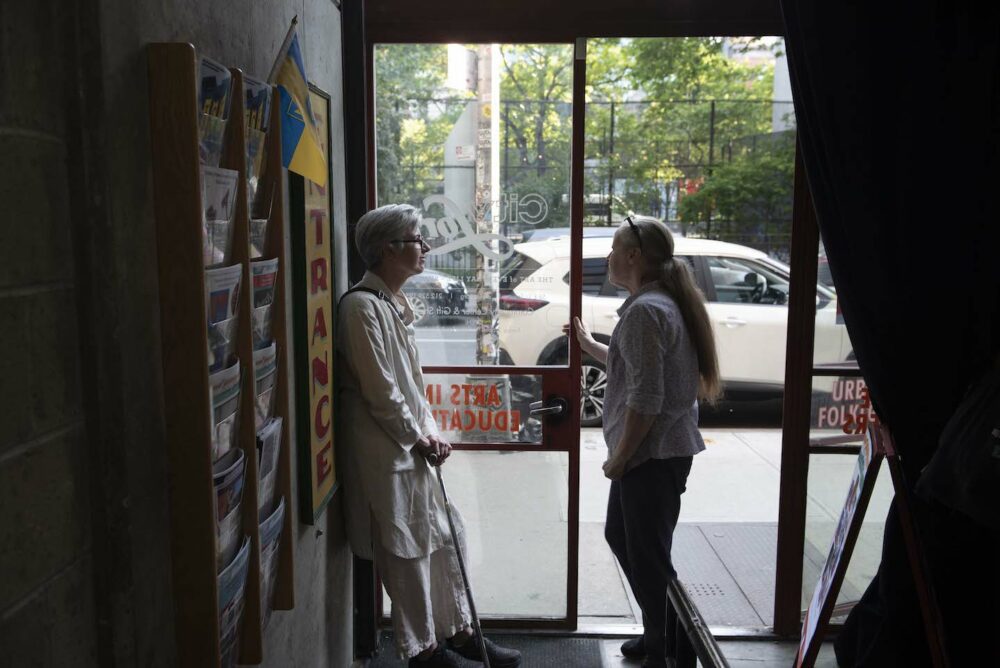

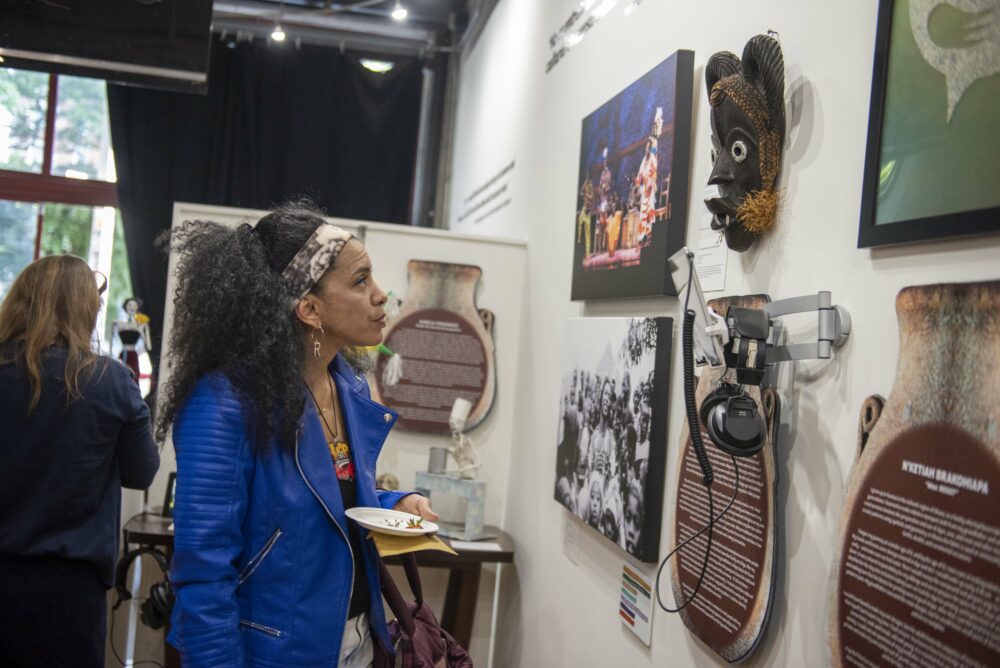
Funders: The National Endowment for the Arts, The Hearst Foundation, The New York City Department of Cultural Affairs in partnership with the City Council, The New York State Council on the Arts with the support of the Office of the Governor and the New York State Legislature
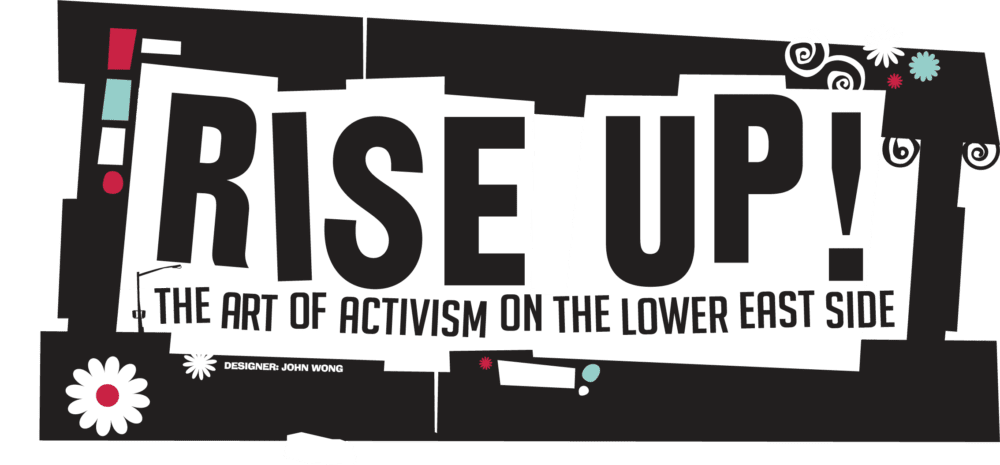
December 16th, 2022 – May 7th, 2023
Rise Up! The Art of Activism on the Lower East Side is an oral history-based place-marking project honoring sites of cultural and arts activism. This exhibition includes thirteen stories, among countless neighbors, past and present, whose spirit and striving, character and creativity have rendered the Lower East Side a bastion of artful agitation.
Rise Up! has been enriched by advisors whose deep roots and broad visions have guided our selection of local landmarks and knowledge-bearers for inclusion in this project. They continue to connect us to people, places, histories, and traditions that make the Lower East Side a neighborhood where residents are empowered to resist, rock the boat, and rise up.
We acknowledge that this exhibition is mounted on the traditional land of the Lenape Peoples, past and present, and we honor with gratitude the land itself and the people who have stewarded it throughout the generations. We thank trailblazers we have lost for fostering a community where their descendants can step forward, organize, and face the challenges of their time.
The Rise Up! exhibition is not and does not aim to be comprehensive. Instead, we hope to offer snapshots into grassroots, innovative, and necessary strategies for setting change in motion and shaping the world we want. Many of these cultural resistance narratives are underrepresented, overshadowed, and told in isolation. We hope that Rise Up! helps to promote representation, point to inter-connections, and paint a robust portrait of the powerful people—artists, activists, and allies, alike—from the Lower East Side.
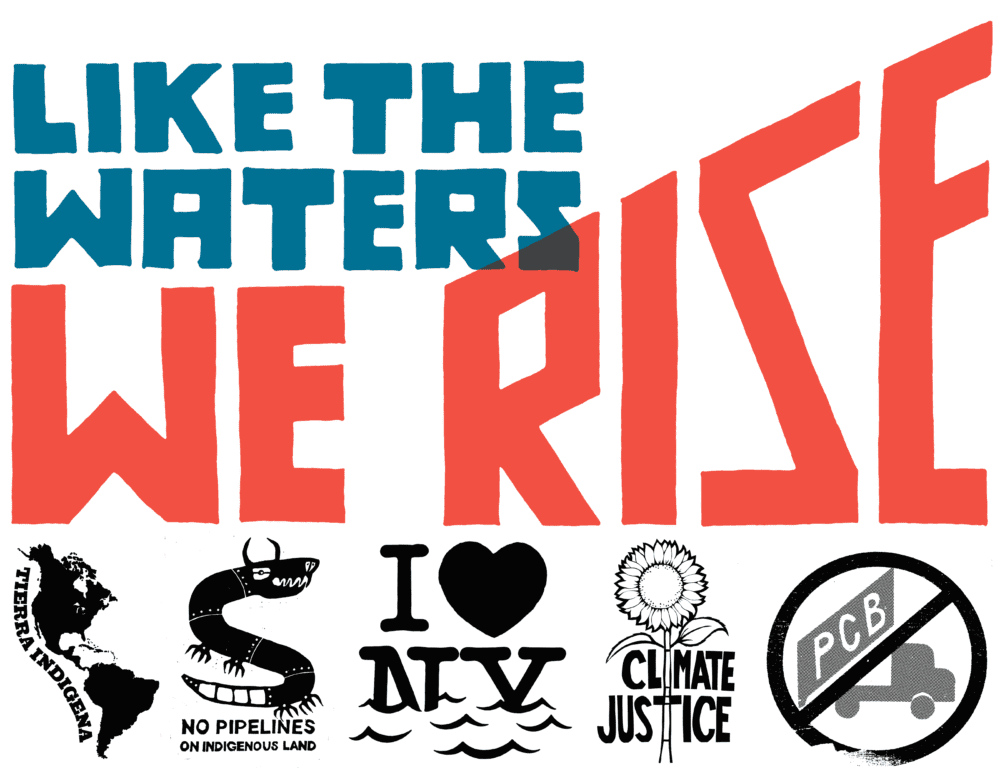
Like the Waters We Rise: Climate Justice in Print
April 29, 2022 – September 1, 2022
Like the Waters We Rise: Climate Justice in Print, is an exhibition celebrating the bold, artful, graphic work of print-based artists in the climate justice movement. The exhibit presents a collection of art, ephemera, posters, photographs, and historical documents charting recent waves in community-based climate justice organizing.
The scale of the climate crisis we are collectively facing is daunting, and it is our hope that each piece offers a portal to an inspiration, a victory, or a teaching about how people-powered action is the most viable strategy we have for building the future. Each element of this collection has been carefully selected to support an understanding of climate justice as a rich, intersectional, often arts-centered movement of movements driven by a multitude of visions for a better world.
The works presented in this collection are part of a “box set” (print-based exhibition in a box) developed in partnership with Booklyn, an artist-run non-profit that archives, re-prints and distributes the work of artists and social justice groups that address urgent cultural issues of our time.
The contents of Like The Waters We Rise were selected and organized by Raquel de Anda and Josh MacPhee with support from LJ Amsterdam for the publication and educational activities. The box set and its publication were produced with generous support from the Nathan Cummings Foundation and the Interference Archive.
Five Oceans in a Teaspoon
an exhibition of visual poetry written by Dennis J Bernstein, visualized by Warren Lehrer
SEPTEMBER 19 – NOVEMBER 23, 2019
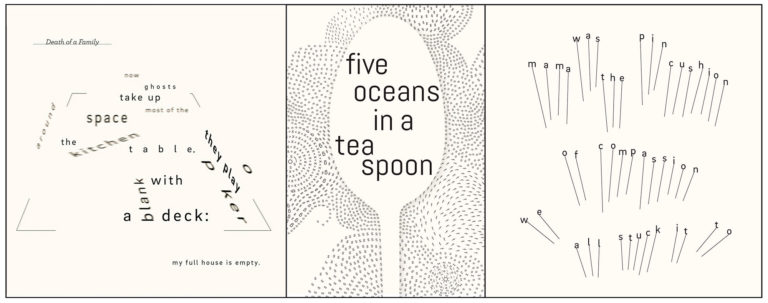
Visualizing Dyslexia, Alzheimer’s, Patterns of War and Relationships Through Visual Poetry
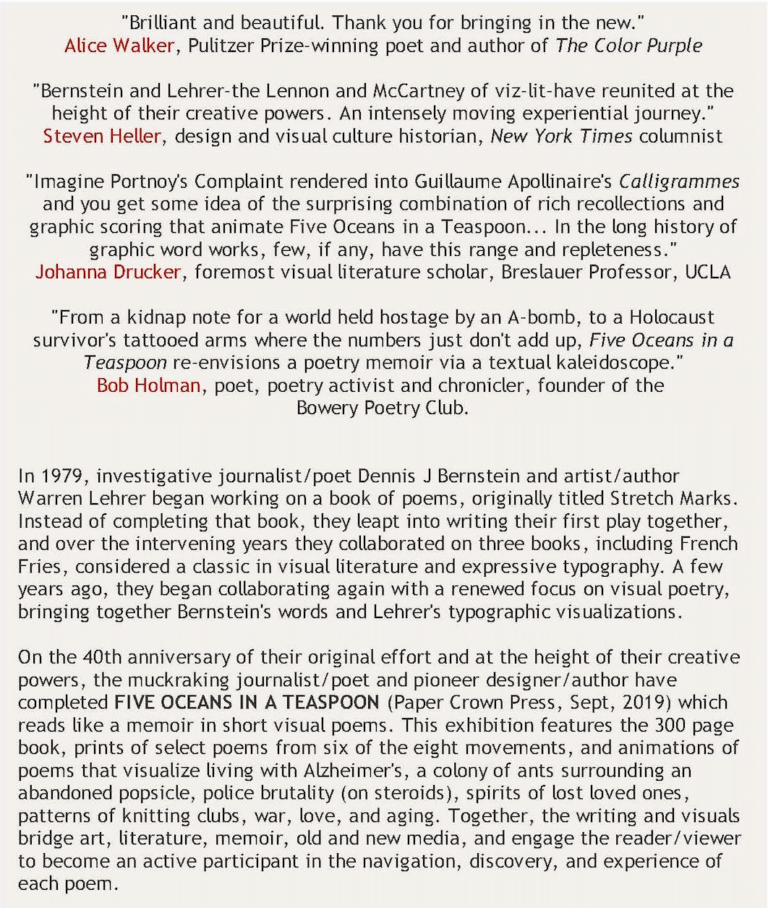
GRAFFITI WARRIORS: Bama and Pistol, Pioneers of Subway Art
June 27th, 2019 – September 13th, 2019

In the early 1970s, the felt-tipped, penned initials on New York City’s subway morphed into multicolored lettering and illustrations sprayed on the trains and tunnels with aerosol paint cans. Inner-city kids from the Bronx, Manhattan, and Brooklyn viewed the trains as a rolling canvas showcasing their art for all New Yorkers, rich and poor alike. In so doing, they pioneered an indigenous urban American art form–graffiti, now recognized worldwide as the visual component of hip-hop culture. This exhibition celebrated the past and present art of two graffiti artists–Richard Admiral, Jr. and his buddy Lonnie Heller, aka Bama and Pistol–who helped pioneer subway graffiti before the art form was chronicled by acclaimed photographers Henry Chalfant and Martha Cooper in the late ’70s.
Waterfront Heroes
March 7th, 2019 – June 21st, 2019
The Waterfront Heroes exhibit featured 10 artist/activists working in the Bronx, Lower Manhattan, Brooklyn, Staten Island and Long Island who are working to preserve the waterfront in key ways. They included painter Naima Rauam who has devoted herself to painting the Fulton Fish Market, both its current incarnation in the Bronx and its glorious history at the Seaport; Rocking the Boat which teaches boat building to underserved youth in the Bronx, Bayhouse owners from both the Rockaways and Long Island; and the Waterfront Museum in Brooklyn on a barge rescued and restored by David Sharps.

Waterfront Heroes is an interpretive exhibit that recognizes individuals and groups who are saving our region’s maritime heritage and traditions, so that future generations can learn about the tremendous history of our region’s waterfront cultural treasures. Curated by Long Island Traditions, City Lore and folklorists Naomi Sturm and Dan Ward, the exhibit celebrates ten unique folk artists and tradition bearers from Staten Island, New York City’s five boroughs, and Long Island. The exhibit includes historic and contemporary photographs by noted photographers Thomas Pich, Martha Cooper, Mike Busch/Great South Bay Images and others, along with curated audio pieces collected by folklorists and ethnographers Molly Garfinkel, Nancy Solomon, Steven Zeitlin, Naomi Sturm and others.Those profiled in the exhibit include Samir Farag/Museum of Maritime Navigation & Communication, Tom Ferrie of the Sandy Hook Pilots Association, Waterfront Barge founder David Sharps, steam whistle collector Conrad Milster, Rocking the Boat, the South Shore Bay House Owners Association and the North Oyster Bay Baymen’s Association.
Yiddish New York
Visual Arts Exhibition
“…With the Kisses of Their Mouth…”
Eros and Spirituality
December 6th, 2018-January 31st, 2019

“Sleeping Over Hills” by Gabrielle Broome
Yiddish New York, an annual celebration of Yiddish music, language and culture, was proud to collaborate with City Lore on 2018’s art exhibition. The exhibition was curated by Deborah Ugoretz and Tine Kindermann. The theme was:
“…With the Kisses of Their Mouth…”
Eros and Spirituality
Many world traditions explore, often controversially, the connection between the sacred and the profane. In Shir HaShirim, the Song of Songs, a poem that appears in Hebrew Scripture, is the lover a person or the deity? Where do the physical and the spiritual body meet? What role does ecstasy play in the religious experience? Can it become the religious experience even in the absence of a defined religion?
We asked artists: how can this seeming dichotomy be addressed through the visual arts? How can the abstract spiritual be expressed through sensual physical media? Do you see these elements as a contradiction, or do they inhabit a shared space?
Artists of all beliefs and identifications were invited to submit visual art in all media that grapples with these questions.
Laurie Russell
Repackaged: Plastic Bag Works
November 9-18, 2018
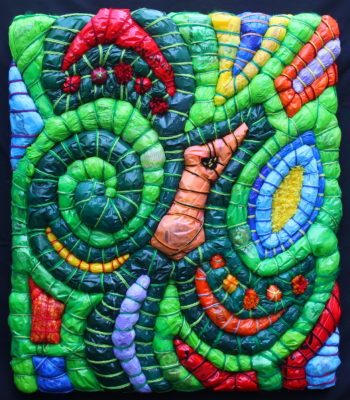
Sea Creature
With the ubiquitous plastic bags accumulated from grocery stores and other commercial establishments, Laurie Russell has developed a way to make wall reliefs, using yarn to sew the bags onto burlap stretched over a frame. The fact that the plastic bags have varying degrees of transparency allows her to combine colors in layers, thus enriching them, and to play with the text or the graphics on the bags. The bags, too, are fraught with contemporary content–as symbols of consumerism, eco-consciousness, and carbon footprinting.Russell’s many influences include molas (the colorful fabric panels stitched by the Kuna Indian women of the San Blas Islands); African American patchwork, strip, and crazy quilts; the high-pile Finnish Rya rugs; the organic forms of Antoni Gaudí; aerial views of Peruvian croplands; stained glass windows; tile floors; and the humble potholder. These sources–remixed, rewoven, reimagined–converge in a body of work entitled Repackaged: Plastic Bag Works.Visit Laurie’s site laurierussellart.com
What We Bring: New Immigrant Gifts
APRIL 6TH – NOVEMBER 1ST, 2018

SPOTLIGHTING THE CONTRIBUTIONS OF ARTISTS FROM
NEW YORK CITY’S IMMIGRANT COMMUNITIES
What We Bring: New Immigrant Gifts adds to the national dialogue on immigration, bringing in to focus the cultural contributions of new immigrants. With this exhibition, we mark the 50th anniversary of the Hart-Celler Immigration and Nationality Act, implemented in 1968, which inaugurated a new era of immigration from Asia, Latin America, Africa and the Caribbean. What We Bring celebrates the rich layers of creativity, tradition, and increased cultural diversity that the law set in motion, especially in New York City, where 6-in- 10 residents are first generation or the children of immigrants.
The selected artists, some widely known, some known primarily in their own communities, span 25 countries and artistic disciplines ranging from music to cooking, poetry to dance, visual arts to theater.
After a four-month run at City Lore, Zeitlin has plans for What We Bring: New Immigrant Gifts to travel to each of the five boroughs. A national tour is also in the works. The exhibition is funded by The National Endowment for the Arts and the Andrew Mellon Foundation, along with the New York State Council on the Arts. The exhibit is cosponsored by the Center for Traditional Music and Dance and the CATCH consortium.
RESISTANCE!
December 14, 2017 – February 25, 2018

YIDDISH NEW YORK’S 2017 VISUAL ARTS EXHIBITION
Yiddish New York, an annual celebration of Yiddish music, language and culture, was proud to collaborate with City Lore to present 2017’s art exhibition. The exhibition was curated by Deborah Ugoretz and Tine Kindermann.
The theme was RESISTANCE!
The Jewish holiday of Chanukah reminds us that it is a struggle to maintain the values that bring meaning to our lives. It tells us that the resistance of a few against a might force can bring about change if the effort is consistent and passionate. With that in mind, the curators asked artists to contemplate the meaning of RESISTANCE !
Resistance… a word with urgent relevance to events past and present.
What defines resistance?
As the dictionary defines it:
1) the refusal to accept or comply with something; the attempt to prevent something by action or argument.
2) the ability not to be affected by something, especially adversely.
The curators asked: Is resistance always in reaction to events or ideas? Is it always in opposition? What are expressions of resistance in daily life or under extreme circumstances? How do artists transform this concept into concrete form?
The curators of RESISTANCE! hoped that the work in the exhibition would inspire viewers to think about what they might do to motivate themselves to RESIST something negative that has worked its way into their hearts and minds.
For more information about the Yiddish New York Festival go to http://www.yiddishnewyork.com
Poetic Voices of the Muslim World
December 15, 2016 – May 14, 2017
October 24, 2017 – December 9, 2017
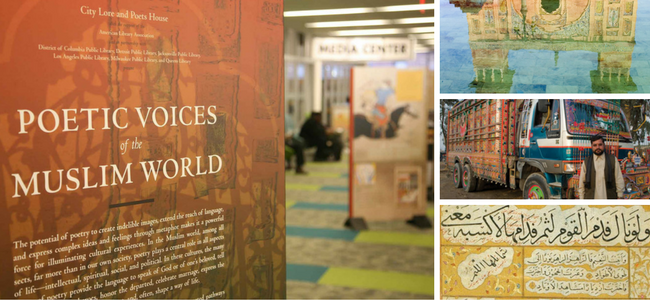
City Lore Gallery welcomes Poetic Voices of the Muslim World, a multi-year initiative including programs and performances presented against the backdrop of a traveling exhibition and companion website.
Presentations by scholars, poets, and musicians celebrate varied styles and types of poetry of rare power and beauty — including ancient oral traditions still practiced today, literary forms that have flourished for more than a millennium, and contemporary poetic arts. Developed by the national poetry library and literary center Poets House and City Lore, Poetic Voices of the Muslim World explores an art form central to the lives of Muslim men and women around the world.
Since 2013, over 300,000 public library visitors in eleven different cities across the United States have viewed the traveling exhibit or attended programs and events related to Poetic Voices of the Muslim World.
The lushly-illustrated, vibrant exhibition, designed by Ralph Appelbaum Associates (RAA), features arresting photography and calligraphic masterworks, as well as the work of poets ranging from Rumi (the best-selling poet in America) to the well-known contemporary poet Adonis. The large visual elements comprise nine printed panels, each measuring four feet by six feet, with the exhibition extending to 48 feet when fully displayed in each of the libraries.
The exhibition at City Lore also features works by the late artist Samina Quraeshi: artist, designer, and educator dedicated to creating greater cultural understanding of her native Pakistan. Artwork inspired by Islamic poetry and created by K-12 students in the A Reverence for Words Institute: Understanding Muslim Cultures through the Arts will also be displayed.
The exhibition highlights the poetic traditions from four major language areas — Arabic, Persian, Turkish, and Urdu — and introduces poetry from Asia, Africa, and diasporic communities in the United States.
“Poetry is the most beloved art form throughout the Muslim world,” said Lee Briccetti, Poets House Executive Director. “Poetry is at the heart of many Islamic cultures and holds a key to these cultures. In fact, poetry is woven into the very fabric of Islamic identity. This exhibition and its accompanying programs turn to that art form to explore the history and social fabric of a variety of Muslim societies.”
Poetry also plays a large role in shaping popular culture, as seen in Abu Dhabi where an American Idol-type Arabic language television program thrills audiences as contestants perform their poems before judges while viewers vote on mobile phones for their favorite poet. Poetry plays a central role in all aspects of Muslim life. In these cultures, the many forms of poetry provide the language to speak of one’s beloved, tell the stories of epic heroes, honor the departed, celebrate marriage, express insights of the moment, speak to God and, often, shape a way of life.
“In the same way that American movies and popular culture have created pathways to understanding the U.S. for those abroad, we can find insight into these varied cultures through the poetries of the Muslim world,” said Steve Zeitlin, Founding Director of City Lore. “These programs provide new ways for Americans to engage with the Muslim world through the interpretation of poetry as they explore what poetry tells us about the history, social fabric and worldviews of a variety of Muslim societies.”
Presented in partnership with the American Library Association, the two-year national initiative is funded through the National Endowment for the Humanities’ (NEH) Bridging Cultures program, with additional support from the Doris Duke Foundation for Islamic Art and New York State Council on the Arts. For a complete list of programs at each library and more information on Poetic Voices of the Muslim World please visit www.pvmw.org.
Apple of My Eye:
The Urban Vision of Elaine Norman
September 13th, 2017 – October 15th, 2017

City Lore was pleased to present Elaine Norman’s vision of the city as the first exhibit in our Deep New York series.
“Simply strolling down any New York street can be a visual adventure and an endless opportunity for discovery,” she writes. “The City has an extraordinary capacity to blend past and present, high-brow and low, traditional and modern.” This vibrant, eclectic and constantly evolving architectural and cultural kaleidoscope has always been Elaine Norman’s passion and source of inspiration.”These days, I love using my iPhone because it gives me the freedom to capture the city in a new way. And my ‘darkroom’ is now an app on that phone, where I occasionally ‘develop’ pictures while riding the bus.”
The work that was on exhibit – photography, photo-collage and more – spans over thirty-five years. Elaine has collaborated with City Lore since our first year – 1986.
Illness & Identity
June 3, 2017 – June 30, 2017
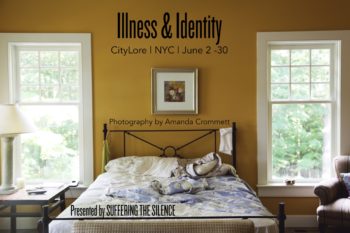
Presented by Suffering the Silence.
Mad Hatters: New York Hats and Hatmakers
May 19 – July 31, 2016
September 15 – November 13, 2016
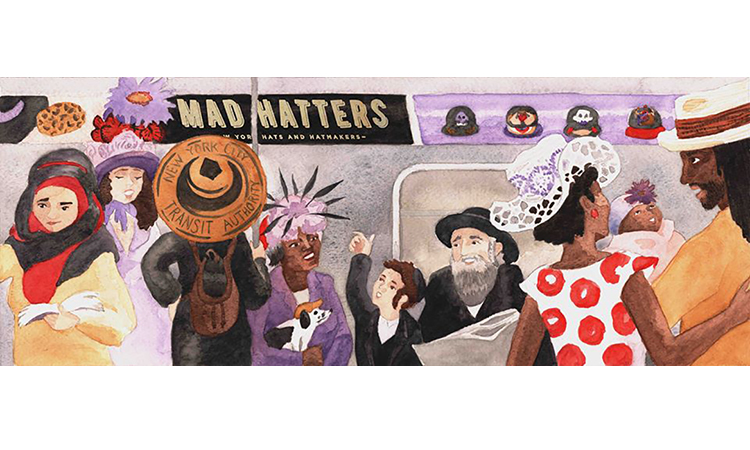
“Cock your hat, angles are attitude,” said Frank Sinatra, a New Yorker at heart. Hats were so important during his time, that Mr. Sinatra had his signature fedoras specially designed with shorter brims than the average ones in order to appear taller to the untrained eye. Sinatra never left his hat at home and neither did the rest of the city during his time. Hats were a necessity, not only for fashion but for blocking the sun as well. In the 1950s, however, the mass-production of sunglasses and the prevalence of automobiles, not to mention James Dean’s coveted coif, ushered in a new era where the everyday hat was no longer needed. But New Yorkers have never left behind their love of hats. In a city of astonishing diversity and traditions, there are still a lot of mad hatters running around the streets of New York.
Mad Hatters showcases the identities that New Yorkers carve out for themselves by donning a simple piece of headwear in a crowded city. With special attention to the City’s defining grassroots folk cultures, the exhibit pays tribute to NYC’s master milliners while also documenting and celebrating the men and women who proudly wear hats to express their cultural traditions or simply for the hell of it. The show features a series of special hats made for the show by the New York Milliners Guild, illustrating “New York hat-itude.”
Produced in collaboration with the Center for Art, Tradition, and Cultural Heritage and the Westchester Arts Council, which staged the show “Hattitude” in 2015 at their White Plains Gallery.
Made possible thanks to The Coby Foundation and The New York State Council on the Arts.
Exhibit image by Maxine Marie.
Boardwalk Renaissance:
How the Arts Saved Coney Island
November 5, 2015 – May 8, 2016
After the closing of Steeplechase Park in 1964, Coney Island went into a steep decline. Like the Bronx, Coney began burning in 1965 and a series of fires continued for the following decade. In the early 1980s, at its lowest point, an odd assortment of passionate young artists were drawn to Coney Island with the dream that their art might return this legendary honky tonk neighborhood to its glory days.
The artists had a wide variety of backgrounds, creating a vital art scene on the boardwalk: playwright Dick Zigun, with a Yale drama degree; artist Richard Eagan, who had a series of dreams about reopening Steeplechase Park; Philomena Marano, who visited Coney as a child, worked with artist, Robert Indiana (of the LOVE sculpture) and founded the Coney Island Hysterical Society with Eagan. Along with renowned artists Harvey Fierstein (Kinky Boots, Hairspray) Charles Ludlam (Theater of the Ridiculous) and Peter Schumann (Bread and Puppet Theater), and photographers Hazel Hankin, Elaine Norman and Charles Denson, who documented the era, they sparked new life and a new love for Coney.
Drawing inspiration from Coney Island’s past, the artists’ conceptual marriage of honky tonk with the avant garde produced installations such as the tableaus in Madam Lily’s aging World in Wax Museum and the Spookhouse, an “arthouse” amusement park ride. As the ‘80s progressed, Zigun began to recognize that the future of Coney was in honky tonk—Sideshows by the Seashore, the Mermaid Parade, and his pioneering Burlesque shows helped establish that Coney Island was here to stay, and the city along with investors listened. The vision of these artists lit a creative spark that saw Coney through desperate times and ignited its future as the centerpiece of New York City and America’s love affair with honky tonk.
Boardwalk Renaissance takes visitors on a trip to the Coney boardwalk of the 80’s and 90’s with installations and artifacts from the era—including a life-size recreation of Spookhouse, an “arthouse” ride, with a hand-painted car and recreation of the Skull entryway, costumes and footage from the first Mermaid Parade, and art inspired by the house under the roller coaster (the same one immortalized by Woody Allen). The Boardwalk Renaissance exhibit brings the Coney spirit back to the heart of the city that started it all.
Sponsored by the Coney Island History Project, Coney Island Hysterical Society and City Lore.
Produced in tandem with the Coney Island USA’s exhibit, Sodom by the Sea Salon. Also, check out the Brooklyn Museum’s exhibit Coney Island: Vision of an American Dreamland!
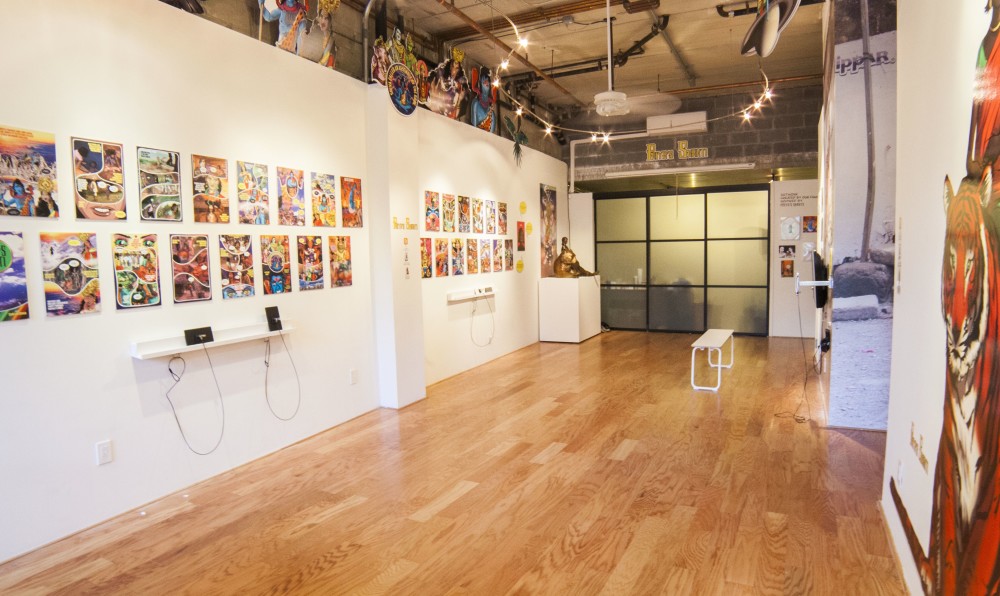
May 7th – July 20th 2015
September 9th – October 11th 2015
Priya’s Shakti:
Augmented Reality Comic Book and Exhibition
The comic book, Priya’s Shakti, which presents a new Indian female superhero and rape survivor who tackles the problem of sexual violence in India and around the world, is having an augmented reality exhibition at City Lore Gallery in New York City. The first of its kind, the entire gallery will be turned into a walk-in comic book where audiences can unlock special animation, videos, real-life stories, and bring other interactive elements to life via Blippar, the leading mobile visual discovery platform and mobile app. The opening reception is May 7, 2015 at 7:30PM and is part of PEN World Voices Festival.
To bring any image in the gallery to life, audiences simply need to download the Blippar mobile app and hold it up to an image from Priya’s Shakti. Instantaneously, the images will come alive and viewers will be able to interact with engaging digital content directly on the device’s screen.
The innovative comic book premiered at the Mumbai Film and Comics Convention in December 2014 and immediately went viral with over 300 feature news stories all over the world. The comic books started a national debate in India on how society treats rape survivors and patriarchal views. The comic book’s superhero, Priya, was honored by UN Women as a “Gender Equality Champion.”
Inspired by ancient mythological tales, the comic book tells the story of Priya — a mortal woman and gang-rape survivor — and the Goddess Parvati as they fight against gender-based sexual violence in India and around the world supporting the movement against patriarchy, misogyny and indifference. Priya has become a global phenomenon and one of the “top ten female comic book characters to watch out for in the future.”
This project will help define the new frontier of integrating literary publications and exhibitions as well as social impact media with Blippar’s proprietary augmented reality technology. Commenting on the comic book, Blippar founder and CEO Ambarish Mitra said, “We’re proud to collaborate with Priya’s Shakti — not only to bring India’s first interactive comic to life for American audiences but to also exhibit the power new technologies have to raise awareness around social causes and create new channels for charitable giving.”
“Talking with several rape survivors, I realized how difficult it was for them to get justice,” said Ram Devineni. “Often, they do not report crimes out of fear for their lives, or to avoid the backlash they may face from their family, authorities, and community. The burden of shame is placed on the victim and not the perpetrators.Priya’s Shakti highlights the threat of sexual harassment and violence that women face on a daily basis unless deeply rooted patriarchal norms are challenged. Priya is a new hero for a modern India.”
“Stories like Priya’s are in the news often these days, not just in India but in all nations and online,” comments artist Dan Goldman. “With Priya’s Shakti came the chance to put a symbolic face to this issue and enlighten all genders about sexual violence, and there’s no format better suited to this than the instantly accessible medium of comics.”
For more information, visit www.priyashakti.com
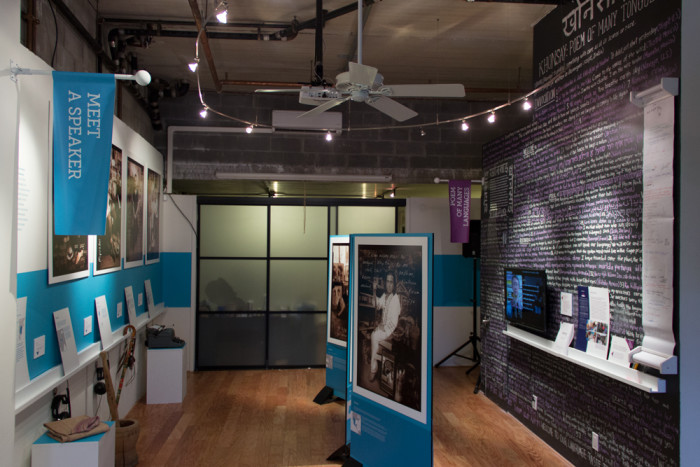
Mother Tongues: Endangered Languages in NYC & Beyond
There are nine different words for the color blue in the Spanish Maya dictionary, but just three Spanish translations, leaving six [blue] butterflies that can be seen only by the Maya, proving that when a language dies six butterflies disappear from the consciousness of the earth.
~Earl Shorris
Opening on January 29th at the City Lore Gallery on the Lower East Side, the new exhibition, Mother Tongues: Endangered Languages in NYC and Beyond, explores NYC as a living language lab where there are more spoken and endangered languages than anywhere else in the world.
The way we speak defines who we are. Whether we speak with a New York City accent or an accent from the country where we were born, or in another language, we contribute to the symphony of linguistic diversity that defines New York City. By the end of this century, over half of the world’s languages will be lost. It has been estimated that over 800 languages are spoken in New York, and 100 are endangered. With the loss of a language comes a loss of culture, a way of thinking and a way of life. This exhibit explores endangered languages spoken in New York, and offers a call to action to conserve linguistic diversity in this global city and around the world.
Mother Tongues offers audiences a unique opportunity to meet and learn about New York City’s remarkably diverse linguistic communities. Here visitors can engage with the Language Laboratory and Meet a Speaker—interactive mixed media booths that showcase individual speakers of endangered languages. From the decline of the New York accent to the wealth of history and tradition behind a single, resonant word, Mother Tongues takes us on a journey through the endangered linguistic diversity of New York City and the world.
Mother Tongues ran from January 29 – April 19, 2015.

Moving Murals:
Henry Chalfant & Martha Cooper’s All-City Graffiti Archive
Moving Murals: Henry Chalfant & Martha Cooper’s All-City Graffiti Archive was City Lore Gallery’s inaugural exhibition that ran from April 6th, 2014 through December 18th, 2014.
Shot during the “Golden Age of Graffiti” in the ‘70s and early ‘80s, Chalfant and Cooper’s images of graffitied subway cars are among the major documents of American popular culture in the late twentieth century. Moving Murals presents their images in a way that they have never been seen in New York: a wall to wall mosaic of over 850 muraled trains, creating an ultimate All City graffiti trainyard environment complimented by wallpapered photographs of the writers in their element. And for the first time, the exhibit provides an interactive audience experience through the addition of Chalfant’s recently published iBook viewed on a large screen, complete with the train image archive, artist interviews, and videos.
These classic train murals, which have been the inspiration and guide for thousands of youthful artists around the world, did not survive on the trains for long before the city cleaned the cars, or the artists’ rivals painted over them. Chalfant and Cooper’s patience and determination in hunting down and capturing these ephemeral masterpieces with their cameras have left the world with a representative cross-section of some of the best work by the most talented young artists who painted New York City’s subway cars in the seventies and eighties. These images pay homage to the young artists from the City’s underserved outer boroughs whose work—though often dismissed as vandalism—challenged contemporary fine arts standards, and lit the fuse for the street art and hip hop explosion heard around the world.



